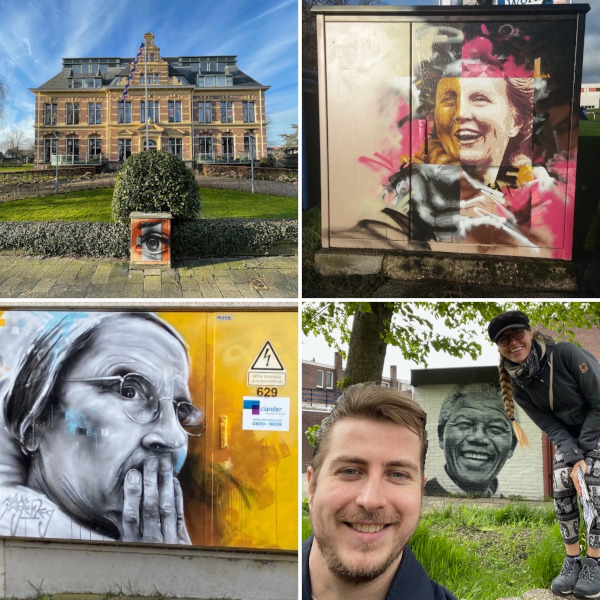
About this walking route
On this Do-It-Yourself walking route, you’ll head from the city centre through the Transvaal, Bonifatius & Rengerspark neighbourhood in search of 30 decorated electricity boxes, 2 halls of fame and 3 large murals. The street art on this route is somewhat smaller in size, but because almost every work was created by a local artist, the connection with the area is all the greater. On the boxes, you will discover famous people, birds and historical images. This walking route is about 6 km long. Check out the entire route in our Highlights on Instagram.
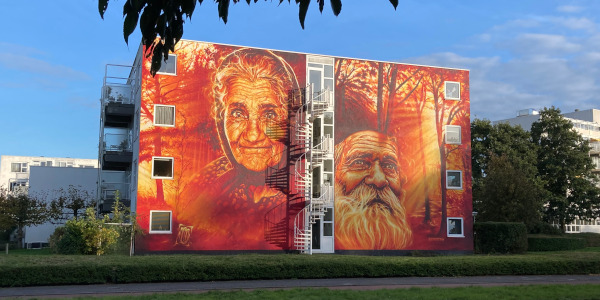
Available
Paper map: This walking route is part of our Street Art Map available at the Leeuwarden Visitor Center, Videokring to-go and Hotel Post-Plaza. This map includes two other routes and costs 5 euro.
Download: You can download this walking route as a PDF version. The walking route costs only 1.5 euros.
Eat and drink
Start the walk with a tasty lunch or drink to-go at Stek. Along the way, get a cup of coffee and some goodies at The Bakery Campus or get some fish at Vishandel de Noorderbrug (tue-sat). And towards the end of the walk, get a nice ice cream at Ice Cream Parlor la Venezia.
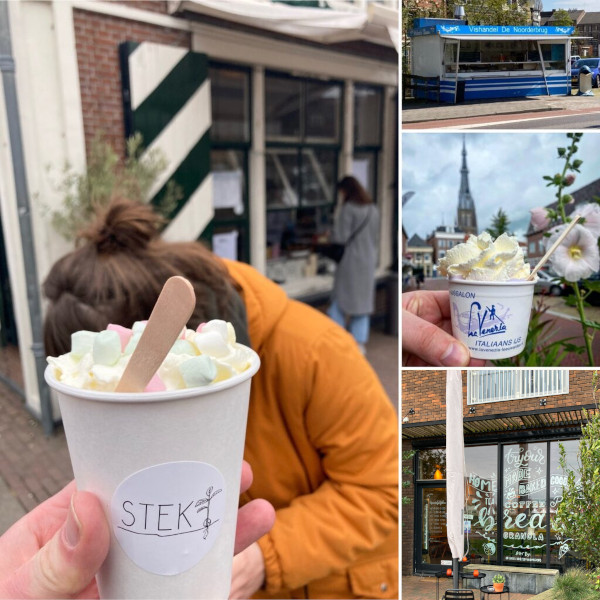
The Stories
Discover the stories behind the artworks by clicking on the titles below. Our guides Henk, Charlotte and Christina have written a story with (almost) every box. The stories tell something about the history of the neighborhood or the name of the street.
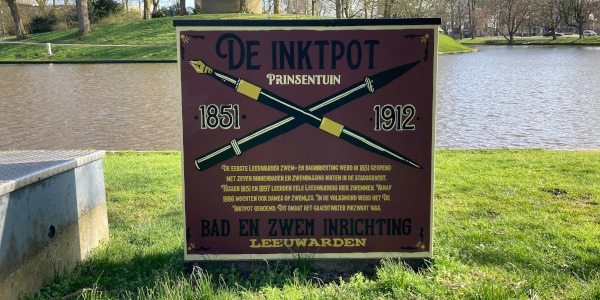
Here at the corner of Noordersingel and Spanjaardslaan was a bathhouse/swimming school in the 19th century. This was a time when there were no sewers or water treatment. Although the swimming water was separated from the canal water, it was not entirely fresh. Therefore, the pool was soon nicknamed ‘the inkwell‘. Because swimmers also regularly encountered a rat in the swimming water, it was also called ‘the rat’s nest’. The pool closed in 1912 due to receding interest.
Location: t.h.v. Noordersingel 100
Artist: Roy Schreuder
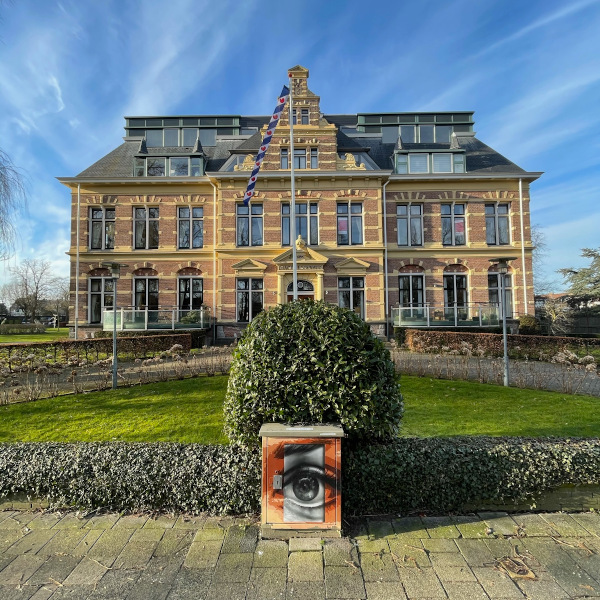
This box is a collaboration between Klaas Lageweg and Roy Schreuder. The orange back was done by Roy Schreuder using a stencil and the black and white part is Klaas Lageweg’s and that was made by hand.
Behind the cabinet you can see the former Diakonessenhospital, which was built in 1894. The building was designed by architect W.C. de Groot. In 1987, the hospital was closed and the building was completely renovated. Only the outer walls are still original and what extraordinary things these walls must have seen. During the Second World War, for instance, resistance fighters were hidden in the infectious disease ward. And in 1953, Siamese twins were successfully separated.
Location: Noordersingel 88
Artist: Roy Schreuder & Klaas Lageweg
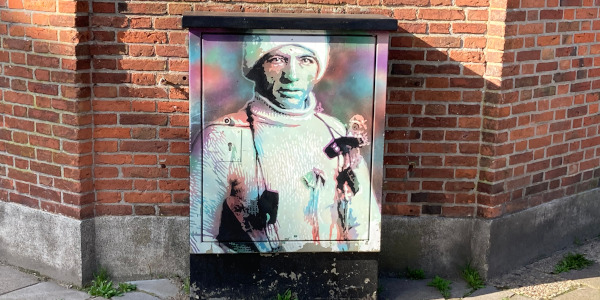
On this box by Roy Schreuder, you can see a picture of Karst Leemburg. He won the Elfstedentocht in 1929, making him the first and only Leeuwarder to do so. In those years, the finish line was between Noordersingel and Prinsentuin. After 1956, the finish moved to the Grote Wielen/Bonkevaart.
Leemburg won the trip despite having a cup of coffee at his uncle’s house on the way. At that point he was behind and it didn’t look like he was going to win. As he skated on, he suddenly turned out to be the leader. This was because the leading group had taken a wrong turn. Leemburg skated on and won! But he also lost something. Namely, his big toe had frozen off.
When asked a few years later by the newspaper Telegraaf whether he was still fit enough to skate the tour, he said he could put his toe in his neck like this….This was because it was on strong water in the windowsill.
Location: On the corner of Singelstraat 1 & Herman Costerstraat
Artist: Roy Schreuder
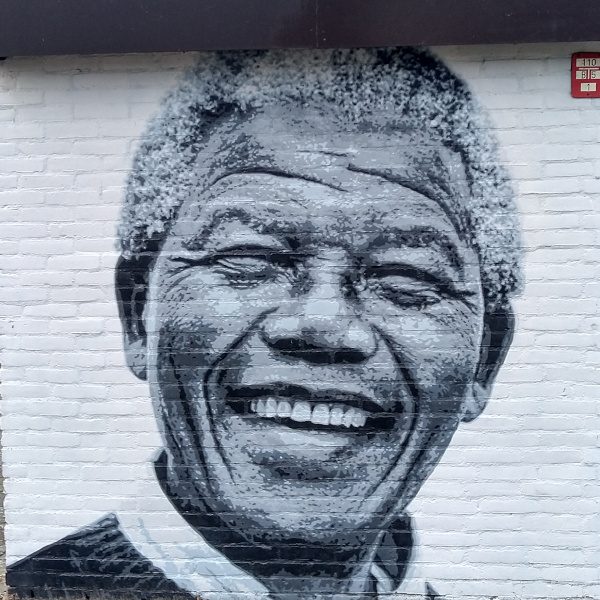
The Transvaal district was built around 1900 and named after a state in South Africa ruled by the Boers. These were descendants of Dutch-speaking settlers from the region around Cape Town. In the 2nd half of the 19th century, they fought two wars against the vast British colonial empire. They eventually lost the Second Boer War and the Transvaal became part of the British Empire. Because the Boers spoke a kind of Dutch (Afrikaans) and they fought as an underdog against our traditional enemy Great Britain, the Boers could count on a lot of sympathy from the Netherlands. Hence, all streets in this district are named after areas or generals from the Boer War.
The square we are now standing on was originally called Pretoria Square, but was renamed Nelson Mandela Square in 1991. Mandela was the symbol of the fight against apartheid during his imprisonment on Robben Island. He is one of the few people to have a street named after him in Leeuwarden during his lifetime.
Location: Nelson Mandelaplein
Artist: Roy Schreuder
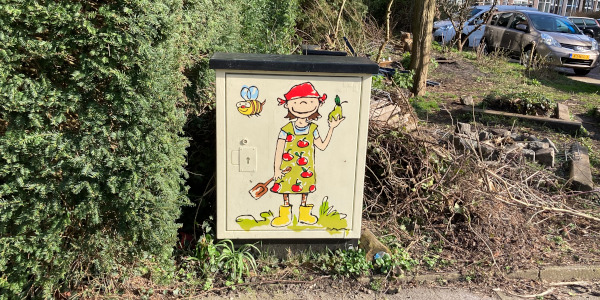
On this box you can see the logo of ‘t Túntsje (the garden). This former weed field behind the box has been transformed by local residents into a snack, play and discovery garden for the neighbourhood. The design of this image is by Sonja Reus and Roy Schreuder put it on the box.
Location: Op the corner of Transvaalstraat & Spanjaardslaan
Artist: Roy Schreuder
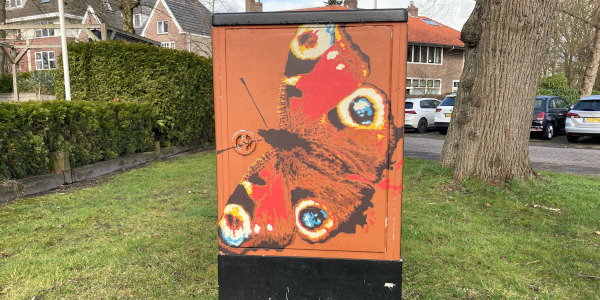
….
Location: On the corner Spanjaardslaan & Leeuwerikstraat
Artist: Roy Schreuder
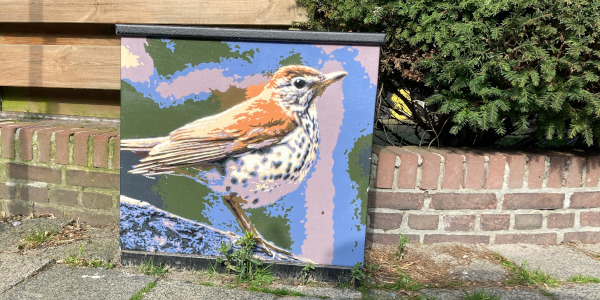
In Lijsterstraat (Thrush Street), Roy Schreuder has pictured a Thrush. The Thrush family has many different species. The blackbird, for example, is also one of them. On the box, we probably see a Song Thrush. A clever bird that uses stones, tiles and branches to open snail shells to get at the meat.
Location: Lijsterstraat 51
Artist: Roy Schreuder
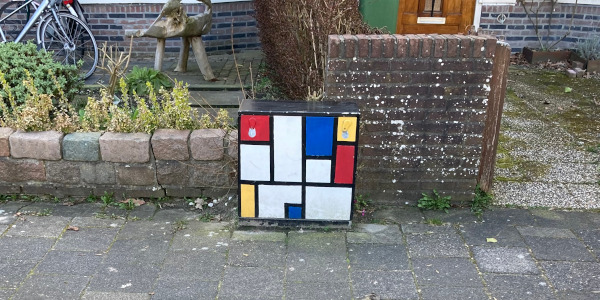
This imitation Mondrian was made by Henk de Vries. The occupant of the house behind and also author of the booklet Kunst kastjes kuier. This booklet came out in 2006 and described the stories of the first 20 painted cabinets in the MTV district. Since then, almost three times as many cabinets have been painted in the MTV neighbourhood!
Location: Lijsterstraat 63
Artist: Henk de Vries
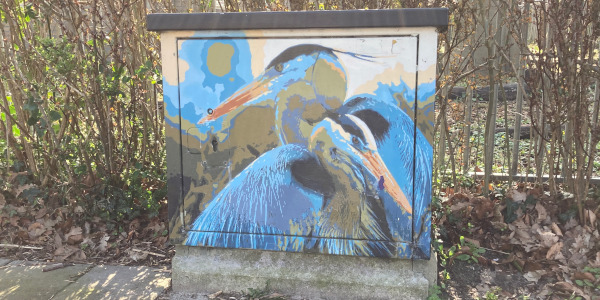
The grey heron used to be a shy bird, but now you can see it everywhere. Herons mainly eat from the ditch (e.g. fish and frogs) but they also eat small mammals and large insects. In winter, herons migrate south. From the Netherlands, they go to France or Africa and from Scandinavia to the Netherlands. But there are also more and more herons that simply stay in the Netherlands in winter. You sometimes see them in groups on a meadow. They then wait for the weather to warm up because they absolutely cannot stand frost.
Location: On the corner of Valkstraat & Jelsumerstraat
Artist: Roy Schreuder
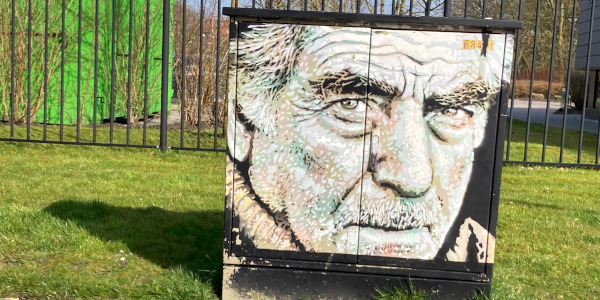
The man in this picture, unlike the images on most other boxes, has nothing to do with this area. Roy Schreuder photographed this Danish fisherman in 2013. Because he has such an expressive head, Roy liked it enough to make it a template for this cabinet.
Location: Jelsumerstraat
Artist: Roy Schreuder
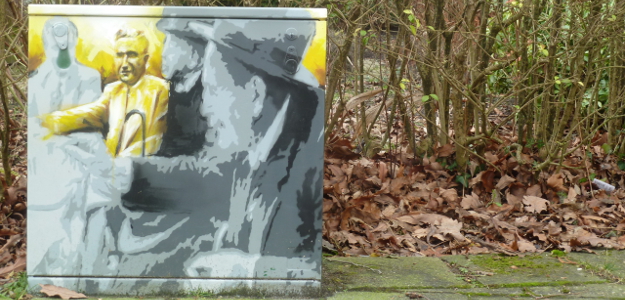
This cabinet features an image of Willy Suskind. It was made by Klaas Lageweg and Roy Schreuder. Suskind was a beloved teacher of German at the MTS in Leeuwarden and he lived here at 9 Spechtstraat. He was also Jewish and in 1940 he feared the coming war. He told his students that he and his family would commit suicide if the Netherlands was occupied by Nazi Germany. He feared that the Nazis would use his disabled son for medical experiments. On 11 May 1940, one day after the German invasion, the family’s bodies were found. They had committed suicide.
Location: On the corner of Spechtstraat & Valkstraat
Artists: Roy Schreuder & Klaas Lageweg
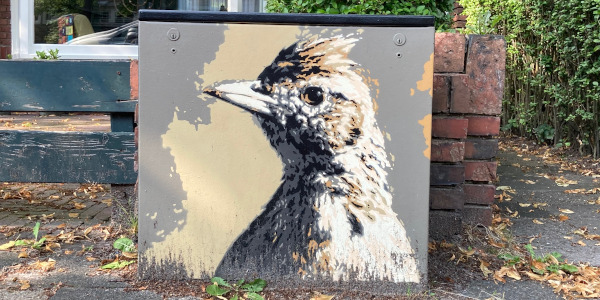
The Lark on this box is probably a crested lark. And it has unfortunately disappeared as a breeding bird in our country, and that is partly due to our compulsion to clean up everything everywhere. In fact, they like rough wild patches and used to be found on all sorts of building sites and industrial areas. Unlike their family member the skylark, they simply sing from the ground and are not shy either. But for their somewhat melodramatic singing, you have to go to southern Europe these days.
Location: Leeuwerikstraat 32
Artist: Roy Schreuder
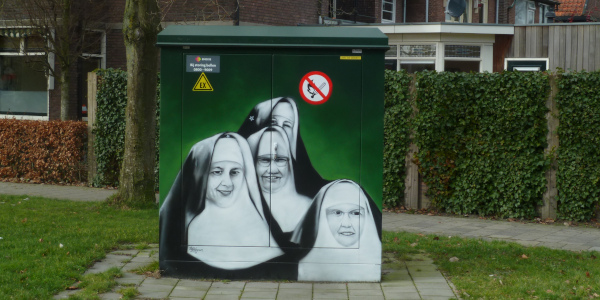
This cabinet shows some sisters from the Boniface Hospital. ‘It’s actually a fragment from a group photo. Most of the nuns looked somewhat masculine, these were the most feminine‘ said Klaas Lageweg with a grin. After the box was vandalised, Roy Schreuder reinstalled the picture and you can also see an additional nun. The original picture taken in 1965 showed even more sisters.
The neighbourhood behind the cabinet is called Bonifatius Park and is named after the former Bonifatius Hospital. Originally, this hospital sat next to Bonifatius Church, so that’s how it got its name. In 1935, it moved to this area. Most Leeuwardeners called it Bonnehos. In 2004, the old hospital closed down. It has since been demolished and made way for new buildings.
Location: Valkstraat / Leeuwerikplein
Artist: Roy Schreuder
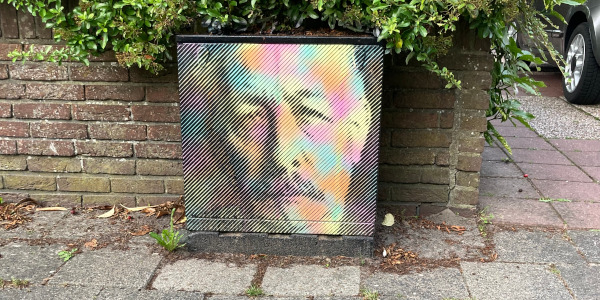
Mr P.J. Troelstra, the foreman of the SDAP and the namesake of this street was put on this cabinet in July 2021 by Roy Schreuder. This street used to be called Stienserweg, but after Troelstra died, the street was renamed in 1930. Troelstra was born in Leeuwarden and grew up in Stiens. He was the leading Dutch socialist politician before World War II. In 1917, after revolutions in Russia, Germany and Hungary, he also proclaimed the communist revolution in the Netherlands. But it turned out, that the Netherlands was not keen on that. This ‘mistake by Troelstra’ caused him to lose influence and prestige. Troelstra was also a poet. His wife, Nienke van Hichtum, also wrote. She is best known for Afke’s Tiental.
Location: Meester P.J. Troelstraweg 96
Artist: Roy Schreuder
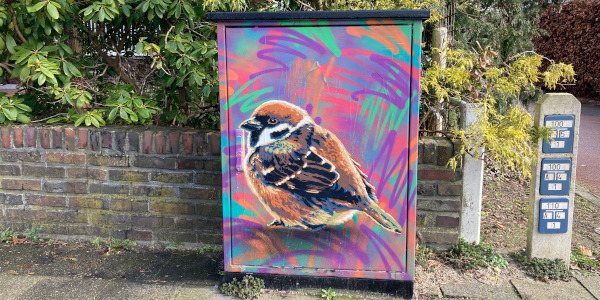
The Sparrow you see here is an updated version of the box previously vandalised. To be precise, a Ringed Sparrow (Passer montanus) is pictured here. You can recognise it by the dark spot on its cheek. The House Sparrow (Passer domesticus) does not have that. Both species live in very cosy colonies. If you have one near you or in your neighbourhood, there is always something to look at! Until the brief past, sparrows were birds that could be found scattered far and wide. Today, both the ringed sparrow and also the house sparrow are on the red list!
Location: Meester P.J. Troelstraweg 100
Artist: Roy Schreuder
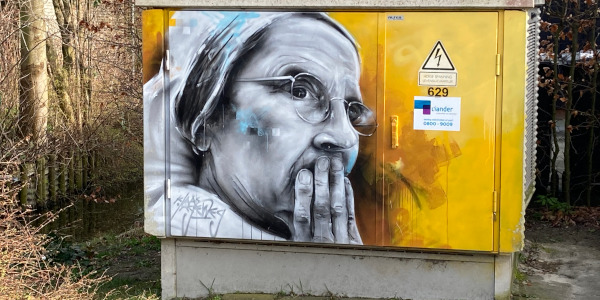
This is Sister Desiree from the Bonifatius Hospital, she was captured on this cabinet by Klaas Lageweg. The Bonifatius Hospital was one of three hospitals in Leeuwarden. In the 1980s, they merged and slowly merged into a new hospital in the south of the city. In 2004, the Bonifatius Hospital was closed. In that year, the picture Klaas Lageweg has painted on this cabinet was also taken. It was taken when Sister Desiree saw the last baby leaving the hospital at the entrance.
Location: Humilitasstraat 40
Artist: Klaas Lageweg
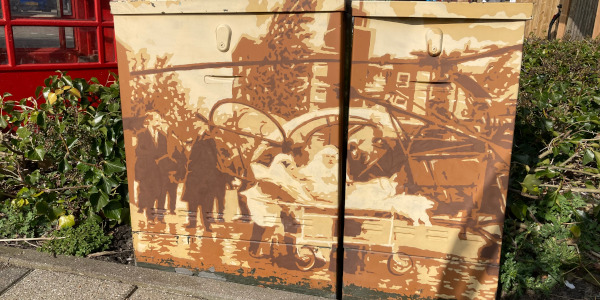
This box shows the opening of the helicopter landing field on the grounds of St Boniface Hospital that used to sit here. It was meant to bring patients from the Wadden Islands to the Hospital in a quick way. The original photo was taken in July 1964.
Location: Hoek Liobastraat
Artist: Roy Schreuder
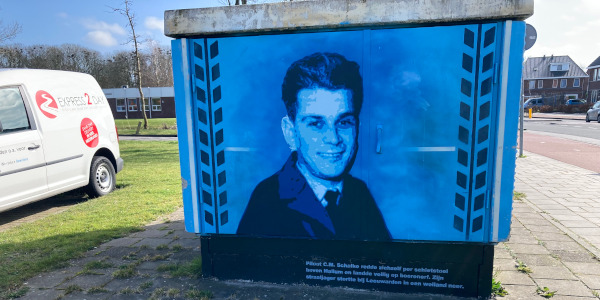
On this cabinet, Roy Schreuder has given us a glimpse of the past. On one side, you see a portrait of 24-year-old Sergeant C.M. Schalke from Katwijk aan Zee. In 1958, his Gloster Meteor fighter jet suffered a malfunction at an altitude of 5,000 metres. Both engines stopped working. Once he descended to 800 metres, he used his ejector seat and landed safely in Hallum. His fighter jet continued flying uncontrolled in the direction of Leeuwarden and crashed here near this box with a loud bang. Fortunately, this was just a meadow at the time and no one was injured.
On the other side of the box, you can see a photo from 1965 showing the farm that stood here at the end of Jelsumerstraat and on the corner of Dammelaan. Where the swimming pool ‘De Blauwe Golf’ now stands.
Location: Jelsumerstraat 12
Artist: Roy Schreuder
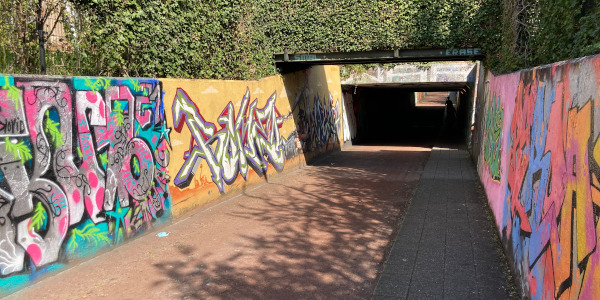
The little tunnel on Rengerspad, under Dammelaan, is a Hall of Fame, this is one of the places in Leeuwarden where you can legally write graffiti. As a result, you regularly see something new here and perhaps something different from the one in our photo. The unwritten rule that applies here is that your work must be more cool, than the one you’re going to paint over.
Location: Rengerspad, tunnel under the Dammelaan
Artist: Various
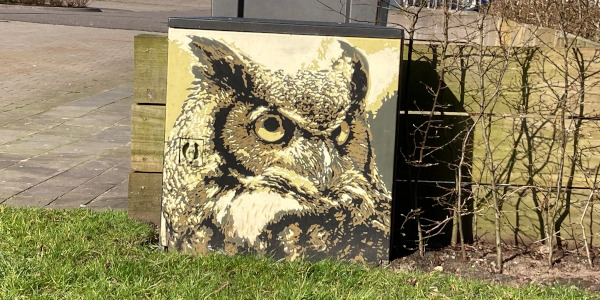
Roy Schreuder has pictured an owl here. The long-eared owl and the eagle owl are hard to tell apart. They both have long ear tufts. However, the eagle owl is two times larger than a long-eared owl. They also differ in breeding pairs. Every year, there are many more breeding pairs of the Long-eared Owl. Between 2015 and 2018, there were around 2,600. Of the eagle owl, there were only 20 breeding pairs in 2020.
Location: Ubbo Emmiuslaan 245
Artist: Roy Schreuder
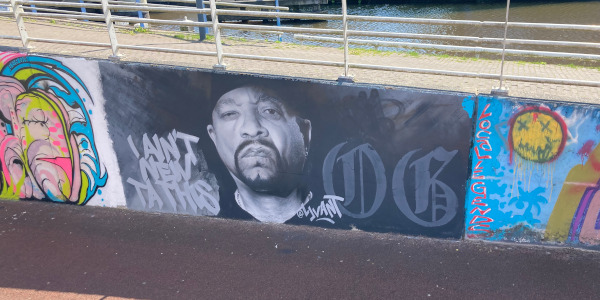
Before you turn right on Dokkumertrekweg towards no 18, you can also turn left. The little tunnel on Dokkumertrekweg, under Dammelaan, is a Hall of Fame; this is one of the places in Leeuwarden where you can legally write graffiti. As a result, you will regularly see something new here and perhaps something different from the one in our photo. The unwritten rule that applies here is that your work must be more cool, than the one you’re going over.
Location: Dokkumertrekweg, tunnel under Dammelaan
Artists: Various
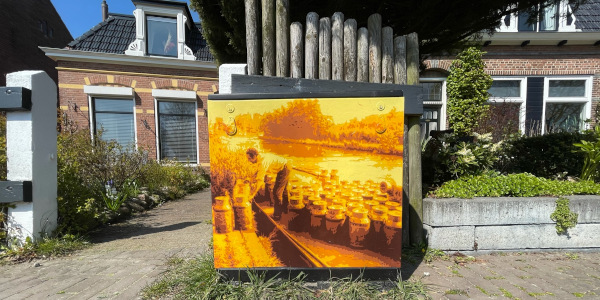
This box shows a photo of the Milk Boat in Snakkerburen, a village further down the river Dokkumer Ee. Milk was collected from farmers and transported across the Dokkumer Ee to town by the milk boat.
Location: Dokkumertrekweg 18
Artist: Roy Schreuder
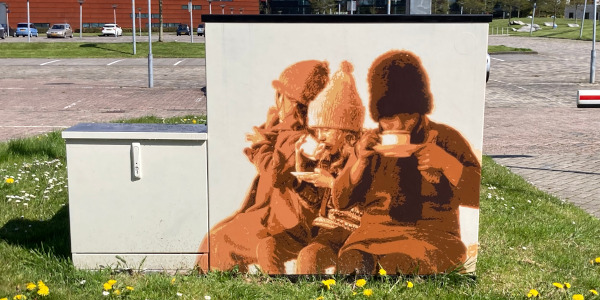
This neighbourhood used to be called the ice rink district. In 1886, the ‘Vereniging de IJsclub’ bought a piece of land next to this cabinet to build an ice rink because it was less and less often possible to hold skating competitions on the canals. In summer, the ice rink was used for athletics, badminton, football and, from 1959, the tourist office even rented it to run a campsite there. As the ice rink was somewhat lower, it turned out not to be the ideal place to pitch your tent when it rained. When an indoor ice hall came to Leeuwarden in 1979, the curtain fell on the rink.
In remembrance of the old ice rink, Roy Schreuder decorated this box with a picture of three children resting at a biscuit stand in 2021. The original picture was taken in 1925.
Location: Dekamastraat
Artist: Roy Schreuder
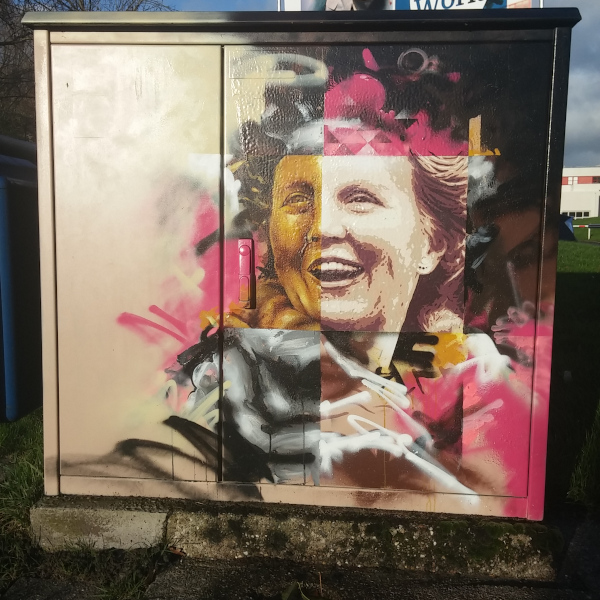
In 1914, Queen Wilhelmina visited the Leeuwarden ice rink located roughly at this spot. Three years later, in 1917, she also took her daughter Juliana to Leeuwarden. They stayed for two nights at their palace the Stadhouderlijk Hof. On Sunday, Wilhelmina attended a service in the Grote Kerk and seven-year-old Juliana enjoyed skating on the ice rink in Leeuwarden. As a tribute to this event, Klaas Lageweg and Roy Schreuder made a portrait of Juliana here.
Location: On the corner of Dekamastraat & Rengerslaan
Artists: Klaas Lageweg & Roy Schreuder

French artist Aero has commissioned a beautiful mural here for Writer’s Block in October 2021. The title of the work is ‘in the autumn of life‘. It is an ode to the residents of the property (care centre the Hofwijck) and elderly people in general.
Locatiom: Corner Rengerslaan & Dekamastraat
Artist: Aero
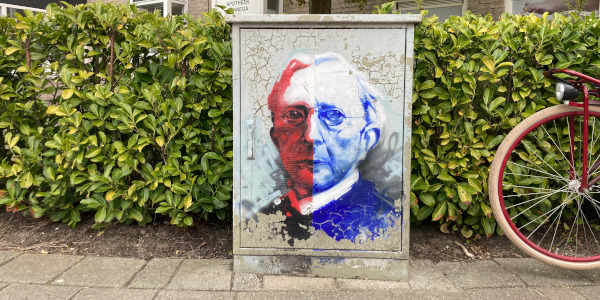
This cabinet features a portrait of Mr Wilco Julius van Welderen baron Rengers (1835-1916). The adjacent Rengerspark is named after him. In 1902, he donated this piece of land to the city to create a walking area, and the park was opened in 1906. Rengers served as a councillor, alderman and mayor in Leeuwarden. He also served in the Upper and Lower Houses of Parliament. He also wrote a number of books on parliamentary history. The cabinet was made by Klaas Lageweg. It has since been replaced by a new version by Roy Schrueder in 2021.
Location: Hoek Spanjaardslaan
Artist: Klaas Lageweg
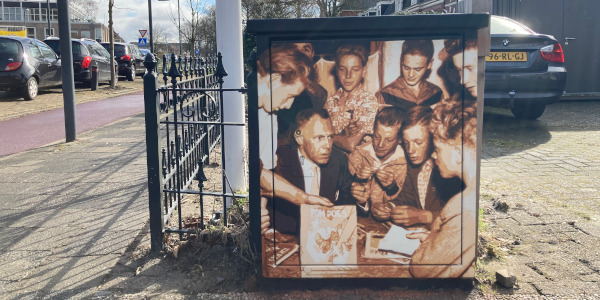
This box shows a photo taken by Sjoerd Andringa in 1957. The image shows young people helping to set up the Youth House on Westerstraat, a street that used to be against Rengerspark.
Location: Singelstraat 24
Artist: Roy Schreuder
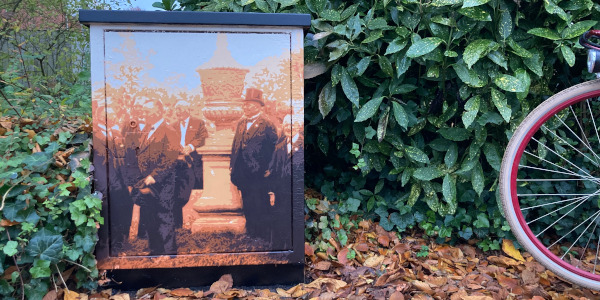
This box shows the festive unveiling of two stone vases donated to the municipality by the tourist office for the Rengerspark in 1922. The box is on the corner of De Wetstraat with Spanjaardlaan. The real vases are still standing in Rengerspark. If you walk into the park from Rengerslaan, you walk straight to them. The vases stand on a pedestal and on the vase you can discover sacrificial fat naked men and garlands.
Location: Corner Spanjaardslaan & De Wetstraat
Artist: Roy Schreuder
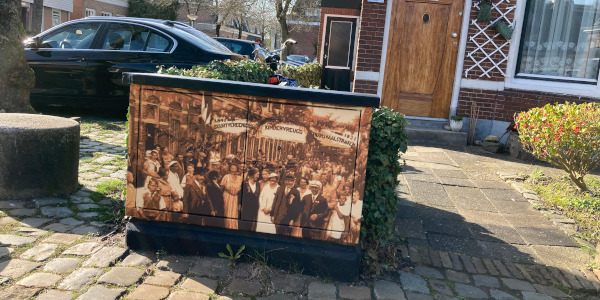
The neighbourhood association Kindervreugd was founded in 1931 and organised an annual children’s party. This box shows a picture of the party on 5 September 1934.
Location: De Wetstraat 14
Artist: Roy Schreuder
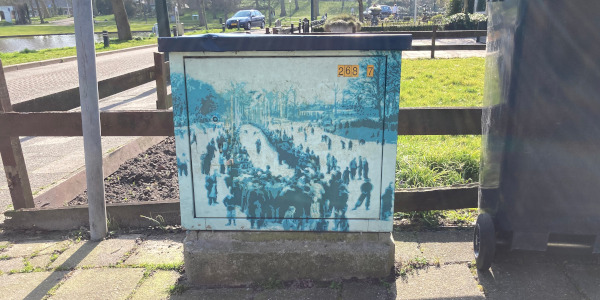
This box by Roy Schreuder shows a photo of the 1954 women’s ice skating competition for the Golden Ball. The winner was Martha Wieringa and she was the first winner of the Golden Ball. However, the competition had been held here for many years and was always called ‘Behind the Golden Ball’ back then. This is because on the corner of Noordersingel and Singelstraat there was an inn called ‘The Golden Ball’. So the skating competition took place behind the Gouden Bal.
When the Ice Club moved to a new ice rink on the Bleekerstraat in 1886, the New Leeuwarder IJsclub was founded to hold a skating competition only during severe winters, when the Leeuwarder city canal at the foot of the Oldehove was frozen over. In 1947, it was decided to actually skate for a golden ball. 1954 was the first subsequent winter that this was actually possible.
Location: On the Corner Bothastraat & Noordersingel
Artist: Roy Schreuder
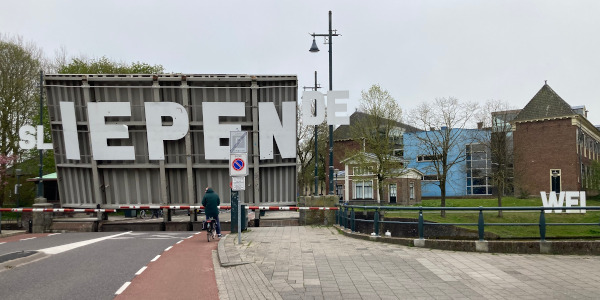
If you are lucky, the Noorderbrug is briefly open. You’ll see a 2018 artwork by Sichtbeerens. Sliepende wei means ‘while sleeping’ in Frisian. But if you translate it literally, it can also mean ‘sleeping road’. And when the bridge is open (iepen in Frisian), the road sleeps.
Location: Under and next to the Noorderbrug
Artist: Sichtbeerens
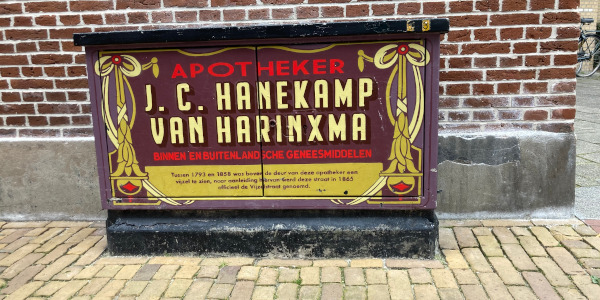
In Vijzelstraat, right at the beginning on the right, you come across this box by Roy Schreuder. On the box you can read why this street is called as it is. Roy posted this image in July 2020.
Location: vijzelstraat 19
Artist: Roy Schreuder
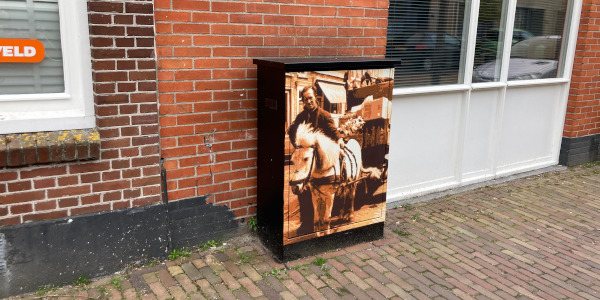
On Nieuweburen, you can find this cabinet by Roy Schreuder with a picture of Jan van der Henne. Jan van der Henne tried to sell products such as petroleum, soap and other household products together with his pony Piet. The cabinet shows him walking through the Nieuweburen in 1962. It was placed on this locker in early 2021.
Walking down the street, you will find the ice cream parlour La Venezia at number 137.
Location: Nieuweburen 56
Artist: Roy Schreuder
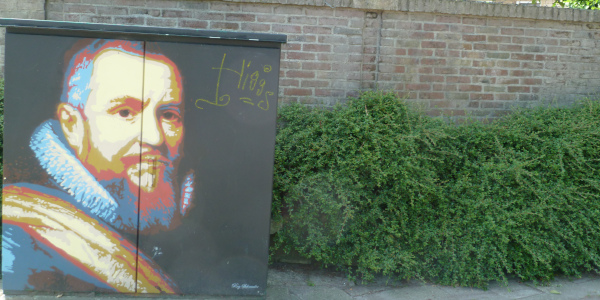
This cabinet by Roy Schreuder shows a picture of Willem Lodewijk van Nassau. The first stadholder of the Nassau’s in Friesland. He was William Orange’s nephew and married his daughter. Us heit, Frisian for Our father, is his nickname because he was very important for the Netherlands and the north in administrative and military matters. The original of this portrait once hung in the Stadholder’s court in Leeuwarden, but is now in the Rijksmuseum.
Location: Wissedwinger 49/ next to the entrance of the prinsentuin
Artist: Roy Schreuder
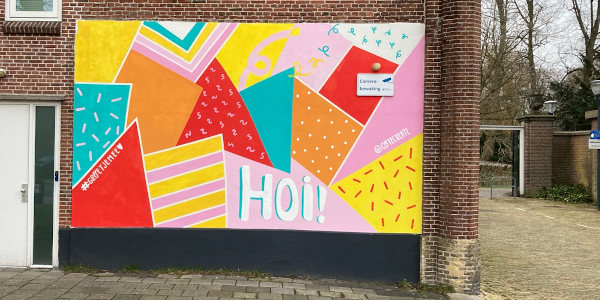
CoteCreate was Leeuwarden’s city artist. Originally from Chile, she fell in love with a Frisian while travelling in Australia. In January 2021, she created this mural for Wini Weidenaar’s #groetjemee initiative. This is a movement to greet each other more often again. Weidenaar noticed that she greeted everyone in the village, but as soon as she went into town she stopped.
Cote: My mural is connected with the same strong idea “connection” be there for each other, bright your day with a bit of colour and happiness hopefully you like it and you enjoy every time when you walk around because is for all of you guys
Location: Groeneweg 3 (Street-side)
Artist: CoteCreate

Klaas Lageweg depicted Saskia van Uylenburg here. She was born in Leeuwarden in 1612 and got engaged to painter Rembrandt van Rijn in 1633. The image on the right is a copy of the first time rembrandt depicted her, three days after their engagement. On the left, you see a modern pixelated version. If you squeeze your eyes you can also see the other eye and the nose and mouth. This also works when you take a picture.
Location: Groeneweg 3 (at the side of the HCL)
Artist: Klaas Lageweg
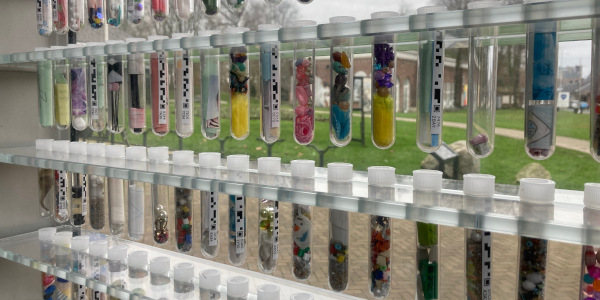
Artist Hein de Graaf created this wall not to shield anything, but rather to show what connects us. In 2018, every Leeuwarder could fill a test tube with something that connected them to Leeuwarden. 16,800 people did so, and their stories together are like the DNA of Leeuwarden. And that fits very nicely on this spot where the HCL (the city’s archive) sits, where they keep the historical DNA of Leeuwarden. You can find each story on the DNA Leeuwarden website.
Location: Groeneweg 1
Artist: Hein de Graaf
Want to walk another Do-it-Yourself route? Click here for the routes we’ve created more.
Follow Roy Schreuder on Instagram
Follow Klaas Lageweg on Instagram
Prefer a personal tour? We like that too! You can always book a private tour. And from Tuesday to Sunday you can also join a public Free Tour. On every Saturday at 12PM we also offer a Leeuwarden Free Tour in English!